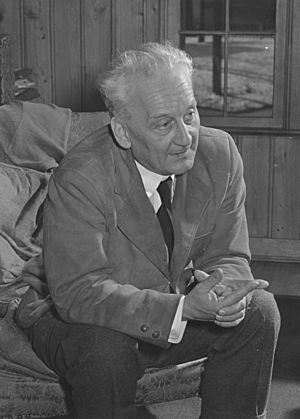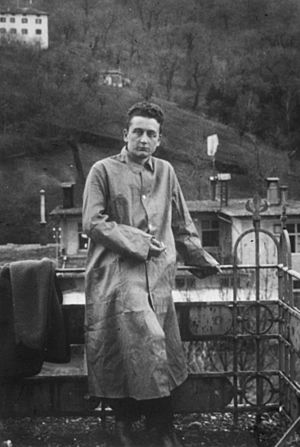Albert Szent-Györgyi facts for kids
Quick facts for kids
Albert Szent-Györgyi
|
|
|---|---|

Szent-Györgyi (Catalan) 1948
|
|
| Born | September 16, 1893 |
| Died | October 22, 1986 (aged 93) |
| Citizenship |
|
| Alma mater |
|
| Known for | Vitamin C, discovering the components and reactions of the citric acid cycle |
| Spouse(s) |
|
| Awards | Nobel Prize in Physiology or Medicine (1937) Cameron Prize for Therapeutics of the University of Edinburgh (1946) Albert Lasker Award for Basic Medical Research (1954) Member of the National Academy of Sciences (1956) |
| Scientific career | |
| Fields | Physiology, biochemistry |
| Institutions |
|
| Thesis | Observations on the functions of peroxidase systems and the chemistry of the adrenal cortex (1929) |
| Doctoral advisor | Frederick Gowland Hopkins |
| Influences | Hartog Jacob Hamburger |
| Signature | |
 |
|
Albert Imre Szent-Györgyi (born September 16, 1893 – died October 22, 1986) was a Hungarian biochemist. He won the Nobel Prize in Physiology or Medicine in 1937. He is famous for being the first to isolate vitamin C. He also discovered important parts and reactions of the Krebs cycle, which is how our bodies create energy. During World War II, he was part of the Hungarian Resistance. After the war, he became involved in Hungarian politics.
Contents
Early Life and Family
Albert Szent-Györgyi was born in Budapest, Kingdom of Hungary, in 1893. His father, Miklós Szent-Györgyi, was a landowner. His mother, Jozefina, came from a family of scientists. Three generations of his family were scientists!
Music was also very important in his mother's family. His mother, Jozefina, wanted to be an opera singer. Albert himself was good at playing the piano, and his brother Pál became a professional violinist.
Education and Discoveries
Szent-Györgyi started studying at Semmelweis University in 1911. He began doing research in his uncle's anatomy lab. He finished his medical education and became a doctor in 1917. In the same year, he married Kornélia Demény.
After World War I, Szent-Györgyi continued his research in different universities. He eventually went to the University of Groningen. There, he studied the chemistry of how cells breathe. This work helped him get a special fellowship at the University of Cambridge. He earned his PhD from Cambridge in 1929. His research involved finding a special acid, which he called "hexuronic acid," in the adrenal glands.
Discovering Vitamin C
In 1930, Szent-Györgyi took a job at the University of Szeged in Hungary. There, he and his research partner Joseph Svirbely made a big discovery. They found that "hexuronic acid" was actually vitamin C! Vitamin C is important for preventing scurvy, a disease.
After another scientist figured out the structure of vitamin C, it was officially named L-ascorbic acid. Szent-Györgyi even used paprika in some of his experiments because it has a lot of vitamin C. During this time, he also continued his work on how cells get energy, identifying steps in what is now called the Krebs cycle.
Nobel Prize and Muscle Research
In 1937, Albert Szent-Györgyi won the Nobel Prize in Physiology or Medicine. He received it for his discoveries about how the body uses oxygen, especially his work on vitamin C and how fumaric acid helps in this process. In 1940, he even offered all his Nobel Prize money to Finland to help them during a war.
In 1938, he started studying how muscles move. He found that muscles contain a protein called actin. When actin combines with another protein called myosin and an energy source called ATP, it makes muscle fibers contract. This is how our muscles work!
Research in the United States
In 1947, Szent-Györgyi moved to the United States. He started the Institute for Muscle Research at the Marine Biological Laboratory in Woods Hole, Massachusetts. He faced some challenges getting money for his research at first. However, he eventually received grants that allowed him to continue his important work.
He discovered that muscle tissue could stay active for a long time if kept cold in a special solution. This meant he didn't always need fresh muscle for his experiments. In the 1950s, he started using electron microscopes to study muscles in even more detail. He became a US citizen in 1955 and was elected to the National Academy of Sciences in 1956.
Later Research on Cancer
Later in his life, Szent-Györgyi became interested in cancer research. He thought about how ideas from quantum mechanics could apply to the chemistry of cancer. He believed that cancer might be related to tiny electronic problems at the molecular level. He helped create a group called the National Foundation for Cancer Research to support this kind of work.
Involvement in Politics
As the government in Hungary changed, Szent-Györgyi helped his Jewish friends escape the country during World War II. He joined the Hungarian resistance movement. Even though Hungary was allied with the Axis Powers, Szent-Györgyi secretly tried to negotiate with the Allies in 1944.
The Germans found out about his plan, and Adolf Hitler himself ordered his arrest. Szent-Györgyi managed to escape and spent 1944 to 1945 hiding from the Gestapo.
After the war, Szent-Györgyi was a well-known public figure. He helped rebuild the Academy of Sciences in Hungary. However, he was not happy with the Communist government that took over. So, in 1947, he moved to the United States. In 1967, he signed a letter saying he would refuse to pay taxes to protest the U.S. war in Vietnam.
Personal Life
Albert Szent-Györgyi was married four times. His first wife was Cornelia Demény, whom he married in 1917. They had a daughter named Cornelia. They divorced in 1941.
In 1941, he married Marta Borbiro Miskolczy, who later passed away from cancer in 1963.
He married June Susan Wichterman in 1965, and they divorced in 1968.
His fourth wife was Marcia Houston, whom he married in 1975. They adopted a daughter named Lola.
Death and Legacy
Albert Szent-Györgyi passed away in Woods Hole, Massachusetts, US, on October 22, 1986. He is remembered for his groundbreaking discoveries, especially his work on vitamin C and cellular energy. In 2011, he was honored with a Google Doodle on his birthday. His life and work continue to inspire scientists today.
Images for kids
See also
 In Spanish: Albert Szent-Györgyi para niños
In Spanish: Albert Szent-Györgyi para niños



